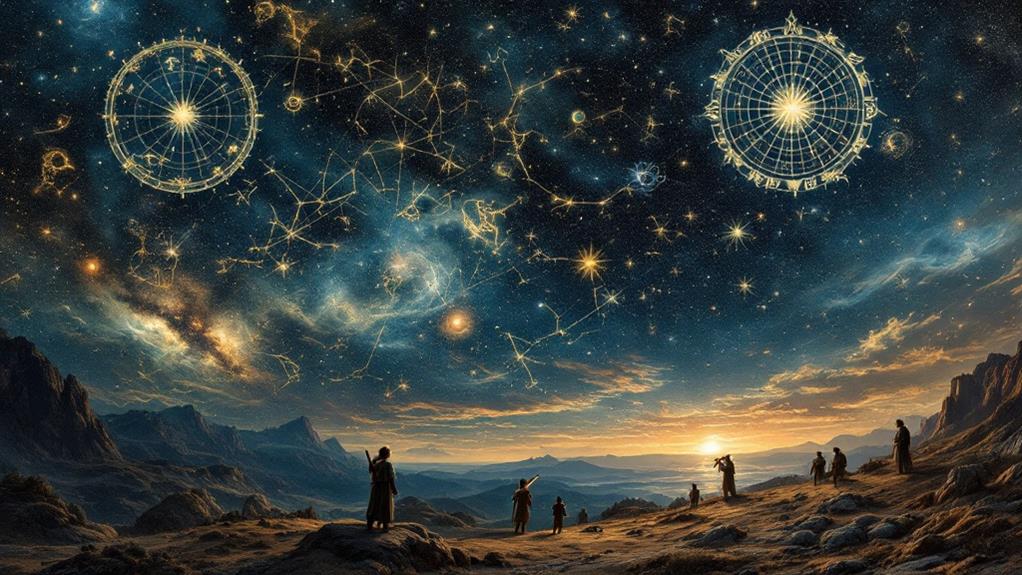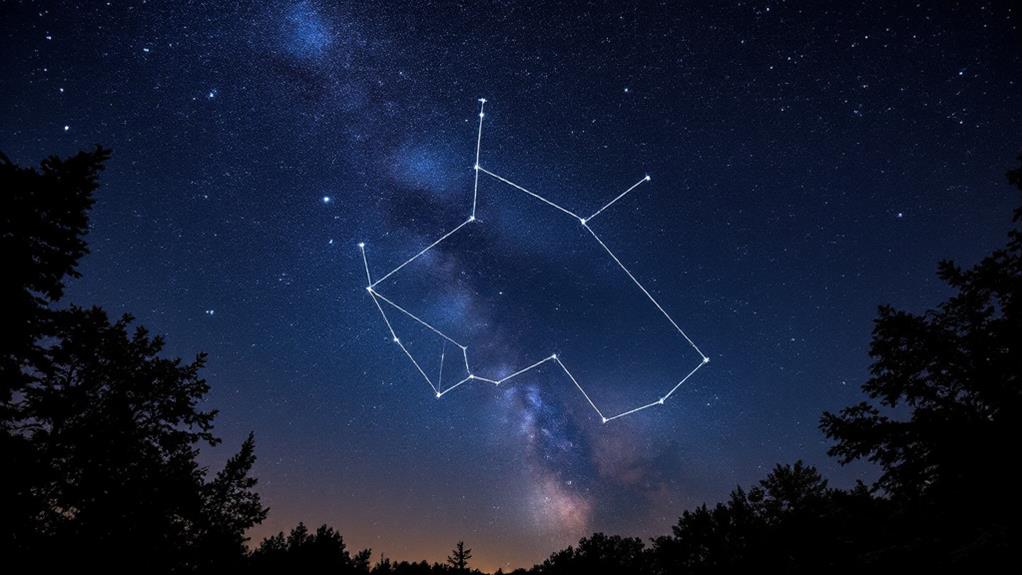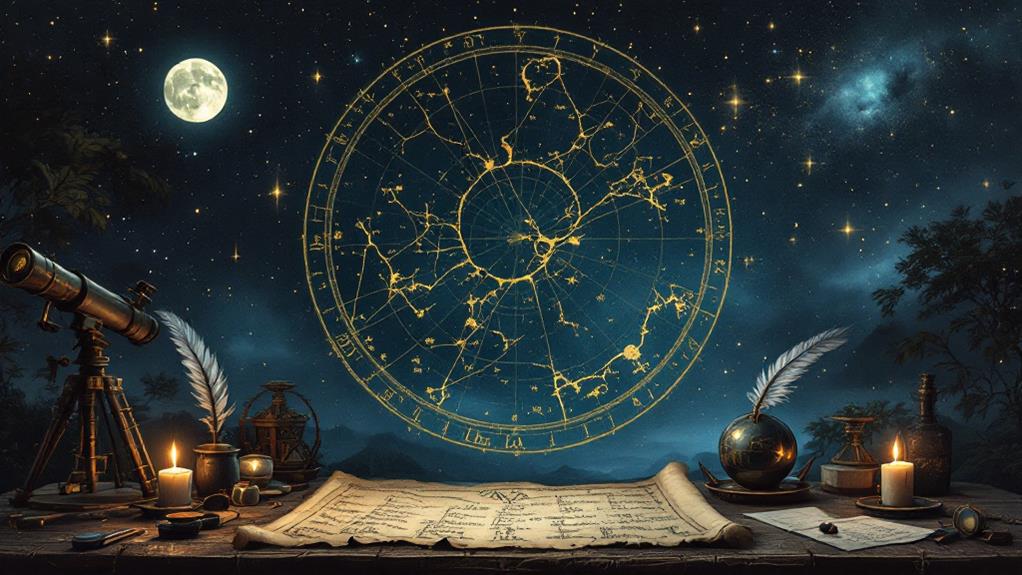When Are the Constellations Visible Each Month of the Year?
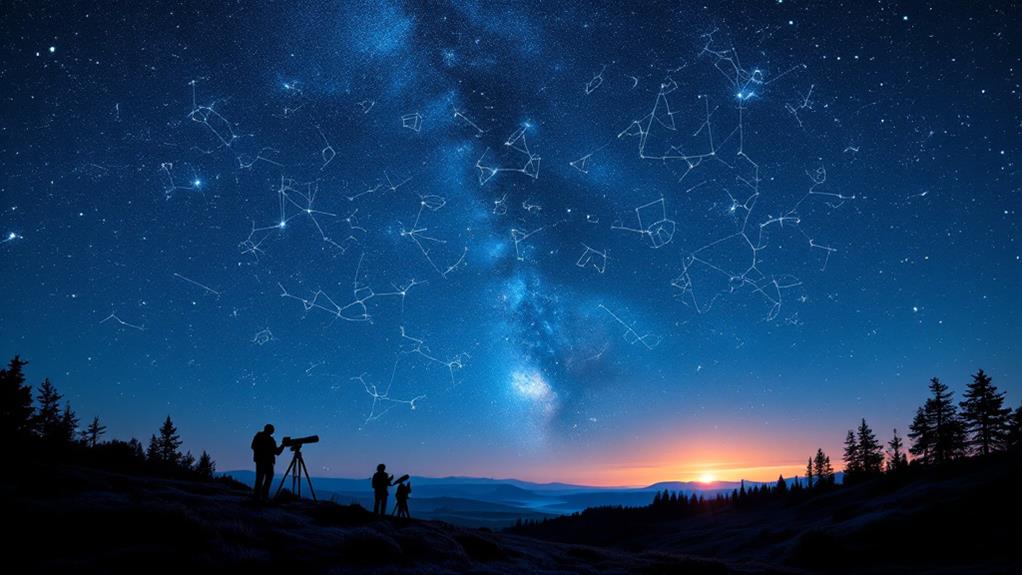
You'll see different constellations throughout the year as Earth orbits the Sun. Winter nights showcase Orion, Taurus, and Gemini. Spring brings Leo, Boötes, and Virgo into view. Summer evenings feature the Summer Triangle and Scorpius. As autumn arrives, you'll spot Pegasus and the returning Pleiades. Some constellations, like Ursa Major and Cassiopeia, are visible year-round in the Northern Hemisphere. The exact timing and visibility depend on your location and the time of night you're stargazing. With a bit of knowledge and practice, you'll soon be able to traverse the changing night sky like a pro.
Winter Sky Constellations
As you gaze up at the winter night sky, you'll find some of the most recognizable and brilliant constellations. In the northern celestial hemisphere, winter brings iconic star patterns like Orion, Taurus, and Gemini into view. These constellations dominate the evening sky from December through March, offering spectacular sights for stargazers.
Orion, the hunter, is perhaps the most famous winter constellation, with its distinctive belt of three bright stars. To its right, you'll spot Taurus, the bull, featuring the V-shaped Hyades cluster and the Pleiades. Gemini, the twins, lies to Orion's left, marked by the bright stars Castor and Pollux.
Other prominent winter constellations include Canis Major, home to Sirius, the brightest star in the night sky, and Auriga, the charioteer. Don't forget to look for circumpolar constellations like Ursa Major and Cassiopeia, which are visible year-round in the northern hemisphere. These never set below the horizon, rotating around the north celestial pole. As winter progresses, you'll notice these constellations shifting positions in the sky, offering new vantage points on familiar celestial patterns.
Spring Celestial Highlights
The spring night sky brings a fresh array of celestial wonders as the winter constellations gradually make way for new star patterns. As you gaze upward during March, April, and May, you'll notice the Big Dipper rising high in the northeast, serving as a guide to other prominent spring constellations. The Big Dipper asterism is part of the Ursa Major constellation and is highly prominent and recognizable.
Look for Leo the Lion dominating the early evening sky, with its bright star Regulus marking the lion's heart. To the east, you'll spot Boötes the Herdsman, featuring the brilliant orange star Arcturus. The constellation Virgo becomes more visible as spring progresses, with its brightest star Spica shining in the southeast.
Spring also offers excellent evening planet viewing opportunities. Venus, known as the "Evening Star," often graces the western sky after sunset. Jupiter and Saturn may also be visible, depending on their positions in their orbits. Don't forget to look for the Spring Triangle, formed by the stars Arcturus, Spica, and Denebola in Leo.
As the season advances, you'll see summer constellations like Hercules and the Summer Triangle rising earlier, heralding the approach of warmer nights and new celestial delights.
Summer Stargazing Favorites

Summer nights bring a spectacular array of celestial objects for stargazers to enjoy. As the warm evenings stretch out, you'll find numerous opportunities to observe some of the brightest stars and most recognizable constellations in the night sky. The Summer Triangle, formed by the stars Vega, Deneb, and Altair, dominates the overhead view and serves as an excellent starting point for your celestial explorations. The Large and Small Magellanic Clouds, two of the Milky Way's closest neighbor galaxies, can also be seen from the southern hemisphere during the summer months.
Don't miss these summer stargazing highlights:
- Scorpius, with its bright red star Antares
- Sagittarius, resembling a teapot shape
- Cygnus, the Swan, flying along the Milky Way
- Hercules, home to the stunning globular cluster M13
Summer is also prime time for meteor showers, with the Perseids in August being a particular favorite. You'll often find seasonal star parties organized by local astronomy clubs during this time, offering a chance to view these celestial wonders through powerful telescopes. As you gaze upward, you'll notice the Milky Way stretching across the sky, its dense star fields and dark dust lanes more visible than at any other time of year.
Autumn Constellation Viewing Guide
Migrating from summer's warm nights to crisp autumn evenings brings a new set of celestial wonders for stargazers to investigate. As the changing seasons progress, you'll notice familiar constellations sinking below the western horizon while new ones rise in the east. This seasonal variance offers a fresh viewpoint on the night sky.
In autumn, you can spot the Great Square of Pegasus dominating the eastern sky. Look for Cassiopeia's distinctive W-shape high in the northeast, and find Andromeda stretching out from Pegasus. The Pleiades cluster, part of Taurus, becomes visible, rising later in the evening as autumn progresses.
Don't miss Perseus, with its famous variable star Algol, ascending in the northeast. Aries the Ram and Pisces the Fish also make their appearances. As you face south, you'll see the "watery" region of the sky, featuring Aquarius, Capricornus, and Piscis Austrinus. The bright star Fomalhaut in Piscis Austrinus is a notable autumn marker. These constellations offer a wealth of observing opportunities, from double stars to deep-sky objects, perfect for exploring on cool autumn nights.
Year-Round Visible Constellations
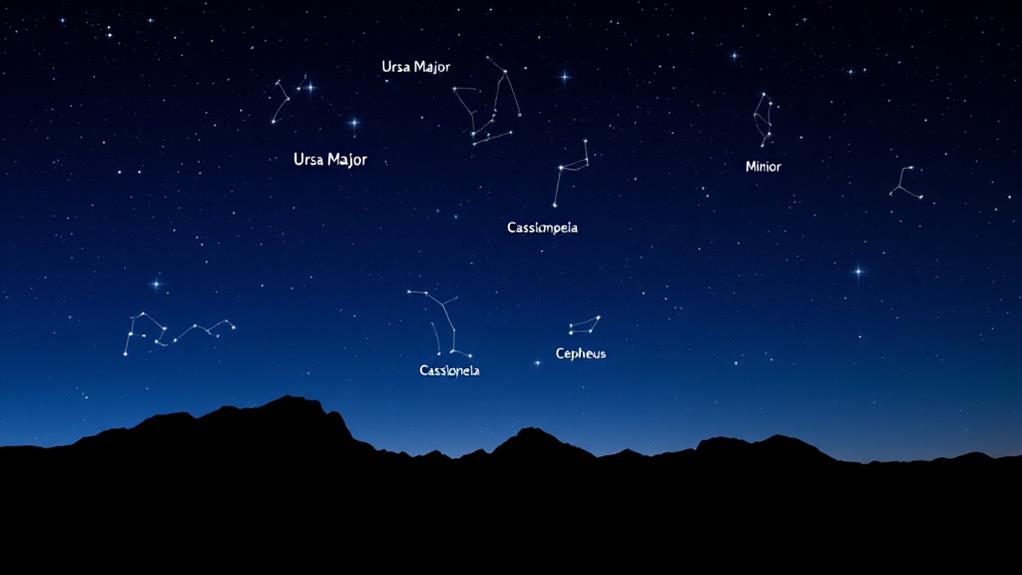
Stargazers in search of constant celestial companions will find comfort in the year-round visible constellations. These celestial patterns remain visible throughout the seasons, offering a reliable guide for both novice and experienced astronomers. In the northern hemisphere, you'll find several constellations that never set below the horizon, providing a consistent celestial vista.
The brightest star patterns that are visible year-round include:
- Ursa Major (The Great Bear)
- Ursa Minor (The Little Bear)
- Cassiopeia (The Queen)
- Cepheus (The King)
These northern hemisphere constellations are known as circumpolar, meaning they rotate around the north celestial pole without dipping below the horizon. You'll find Polaris, the North Star, within Ursa Minor, serving as a fixed point in the night sky. As you become familiar with these constellations, you'll gain a deeper understanding of celestial orientation and the Earth's rotation.
Remember that your latitude affects which constellations are circumpolar for your location. The farther north you are, the more constellations will be visible year-round. By learning to identify these constant companions, you'll always have a familiar reference point in the night sky, regardless of the season.
Tools for Constellation Identification
Identifying constellations becomes much easier with the right tools at your disposal. One of the most powerful resources you can use is Stellarium software, a free, open-source planetarium program for your computer. It allows you to simulate the night sky from any location on Earth at any given time, making it perfect for planning your stargazing sessions or learning about celestial objects.
For on-the-go constellation identification, sky map applications on your smartphone are crucial. These apps use your device's GPS and gyroscope to create a real-time, interactive map of the sky above you. Simply point your phone at the sky, and the app will label stars, planets, and constellations in your field of view.
Other useful tools include star charts or planispheres, which are rotating star maps that show the visible constellations for any date and time. A red flashlight is essential for preserving your night vision while reading charts or adjusting equipment. Binoculars or a small telescope can help you see fainter stars and celestial objects, enhancing your constellation-spotting abilities. With these tools, you'll be well-equipped to examine the night sky and identify constellations throughout the year.
Frequently Asked Questions
How Do Light Pollution and Urban Areas Affect Constellation Visibility?
Light pollution and urban areas greatly impact your ability to see constellations. The effects of urban lighting create a bright sky glow that washes out fainter stars, making it difficult to spot celestial patterns. You'll notice fewer visible stars in cities compared to rural areas. Additionally, the impact of atmospheric conditions, such as smog and haze, further reduces visibility. To fully appreciate constellations, you'll need to venture away from city lights and find clearer skies in less populated areas.
Can Constellations Appear Differently From Various Locations on Earth?
Yes, constellations can appear differently depending on where you're located on Earth. Latitude variations profoundly impact what you'll see in the night sky. As you move north or south, the celestial sphere's positioning changes, altering which constellations are visible and how they're oriented. You'll notice some constellations appear higher or lower in the sky, while others might be completely hidden below the horizon. Your location can even affect the time of year certain constellations are visible to you.
What Causes Some Constellations to Change Shape Over Long Periods of Time?
You'll notice that constellations slowly change shape over thousands of years due to two main factors. First, the precession of the equinoxes gradually shifts Earth's orientation, altering our view of the night sky. Second, stellar proper motion causes individual stars to move independently through space. As stars drift at different speeds and directions, you'll see the familiar patterns of constellations subtly morph over time. These changes are imperceptible in a human lifetime but significant over millennia.
Are There Any Health Benefits Associated With Stargazing and Observing Constellations?
You'll find that stargazing and observing constellations can offer surprising health benefits. As you gaze at the night sky, you're likely to experience improved mental focus and stress reduction. The peaceful act of looking up at the stars can calm your mind and help you disconnect from daily worries. It's a form of mindfulness that encourages you to be present in the moment, potentially lowering anxiety levels and promoting a sense of well-being.
How Do Astronomers Differentiate Between Stars Within a Constellation and Background Stars?
You'll find that astronomers use several methods to distinguish stars within a constellation from background stars. They'll analyze the proper motion of stars, observing how they move relative to each other over time. They'll also measure stellar parallax, which reveals a star's distance by tracking its apparent shift against distant objects. Additionally, they'll consider factors like brightness, color, and spectral characteristics to determine which stars truly belong to a constellation and which are just in the same line of sight.

